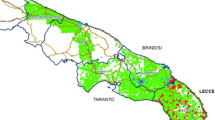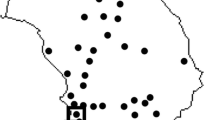Abstract
The olive quick decline syndrome (OQDS) is a disease that appeared suddenly a few years ago in the province of Lecce (Salento peninsula, southeastern Italy). Among the factors that may be involved in its aetiology, the most relevant is Xylella fastidiosa, a quarantine pathogen of American origin, whose presence in Italy represents its first confirmed record in the European Union. X. fastidiosa is a Gram-negative bacterium that invades the xylem of a wide range of hosts, from which it is acquired by xylem-feeding insect vectors and transferred to other plants. The bacterium multiplies within the plant vessels and occludes them, thus impairing water uptake. Besides olive, the Salentian strain of X. fastidiosa infects in nature a number of woody (almond, cherry) and shrubby (oleander, broom, Acacia saligna, Polygala myrtifolia, Westringia fruticosa, Rosmarinus officinalis, Rhamnus elaternus, Myrtus communis) hosts, with no evidence for grapevines or citrus being hosts. The bacterium was isolated in culture and identified as a genotype of X. fastidiosa subsp. pauca, molecularly identical to an isolate from Costa Rica. Philaenus spumarius (meadow spittlebug), a froghopper quite common in the Salento area where it thrives on olive, was identified as the main vector. Disease eradication and sanitation of infected olives are unfeasible. However, strategies are being enacted for restraining the spread of pathogen and vector(s) within the boundaries of the currently infected zone.






Similar content being viewed by others
References
Boscia, D. (2014). Occurrence of Xylella fastidiosa in Apulia. International Symposium on the European Outbreak of Xylella fastidiosa in Olive, Journal of Plant Pathology, 96, S4.97.
Boscia, D., Potere, O., Loconsole, G., Saponari, M., Delle Donne, A., Susca, L., & Martelli, G. P. (2014). The possible role of oleander in the epidemiology of Xylella fastidiosa in the Salento peninsula. International Symposium on the European Outbreak of Xylella fastidiosa in Olive, Journal of Plant Pathology, 96, S4.107.
Cariddi, C., Saponari, M., Boscia, D., De Stradis, A., Loconsole, G., Nigro, F., Porcelli, F., Potere, O., & Martelli, G. P. (2014). Isolation of a Xylella fastidiosa strain infecting olive and oleander in Apulia, Italy. Journal of Plant Pathology, 96, 425–429.
Chatterjee, S., Almeida, R. P. P., & Lindow, S. (2008). Living in two worlds: the plant and insect lifestyles of Xylella fastidiosa. Annual Review of Phytopathology, 46, 243–271.
Cornara, D., & Porcelli, F. (2014). Observations on the biology and ethology of Aphrophroridae: Philaenus spumarius in the Salento peninsula. International Symposium on the European Outbreak of Xylella fastidiosa in Olive, Journal of Plant Pathology, 96, S4.98.
Cornara, D., Loconsole, G., Boscia, D., De Stradis, A., Yokomi, R. K., Bosco, D., Porcelli, F., Martelli, G. P., & Saponari, M. (2014). Survey of Auchenorrhyncha in the Salento peninsula in search of putative vectors of Xylella fastidiosa subsp. pauca CoDiRO strain. International Symposium on the European Outbreak of Xylella fastidiosa in Olive, Journal of Plant Pathology, 96, S4–97.
D’Onghia, A. M., Santoro, F., Yassen, T., Djelouah, K., Guario, A., Percoco, A., Caroppo, T., & Valentini, F. (2014). An innovative monitoring model of Xylella fastidiosa in Apulia. International Symposium on the European Outbreak of Xylella fastidiosa in Olive, Journal of Plant Pathology, 96, S4.99.
Djelouah, K., Frasheri, D., Valentini, F., D’Onghia, A. M. & Digiaro, M. (2014). Direct tissue blot immunoassay for detection of Xylella fastidiosa in olive trees. Phytopathologia Mediterranea, 53. doi:10.14601/Phytopathol_Mediterr-14603
EFSA (2015). Scientific opinion of the risk to plant health posed by Xylella fastidiosa in the EU territory, with the identification and evalaution of risk reduction options. EFSA Journal, 13, 3989. doi:10.2903/j.efsa.2015.3989.
EPPO/OEPP (1992). Xylella fastidiosa. EPPO data sheets on quarantine pests, No. 166.
Giampetruzzi, A., Chiumenti, M., Saponari, M., Donvito, G., Italiano, A., Loconsole, G., Boscia, D., Cariddi, C., Martelli, G. P., & Saldarelli, P. (2015). Draft genome sequence of the Xylella fastidiosa CoDiRO strain. Genome Announcements, 3, e01538–e01514. doi:10.1128/genomeA.01538-14.
Güldür, M. E., Çaglar, B. K., Castellano, M. A., Ünlü, L., Güran, S., Yilmaz, M. A., & Martelli, G. P. (2005). First report of almond leaf scorch in Turkey. Journal of Plant Pathology, 87, 246.
Haelterman, R. M., Tolocka, P. A., Roca, M. E., Guzman, F. D., Fernandez, F. D., & Otero, M. L. (2015). First presumed diagnosis of Xylella fastidiosa causing olive scorch in Argentina. Journal of Plant Pathology, 97(2), 393.
Hopkins, D. L. (1989). Xylella fastidiosa: xylem-limited bacterial pathogen of plants. Annual Review of Phytopathology, 29, 271–290.
Hopkins, D. L. (2014). Control strategies for Xylella fastidiosa. International Symposium on the European Outbreak of Xylella fastidiosa in Olive, Journal of Plant Pathology, 96, S4.99.
Janse, J. D., & Obradovic, A. (2010). Xylella fastidiosa, its biology, diagnosis, control and risks. Journal of Plant Pathology, 92, S1.35–S1.48.
Krugner, R., Sisterson, M. S., Chen, J., Stenger, D. C., & Johnson, M. W. (2014). Evaluation of olive as a host of Xylella fastidiosa and associated sharpshooter vectors. Plant Disease, 98, 1186–1193.
Lindow, S., Newman, K., Chatterjee, S., Baccari, C., Iavarone, A. T., & Ionescu, M. (2014). Production of Xylella fastidiosa diffusible signal factor in transgenic grape causes pathogen confusion and reduction in severity of Pierce’s disease. Molecular Plant-Microbe Interactions, 27, 244–254.
Loconsole, G., Potere, O., Boscia, D., Altamura, G., Djelouah, K., Elbeaino, T., Frasheri, D., Lorusso, D., Palmisano, F., Pollastro, P., Silletti, M. R., Trisciuzzi, N., Valentini, F., Savino, V., & Saponari, M. (2014a). Detection of Xylella fastidiosa in olive trees by serological and molecular methods. Journal of Plant Pathology, 96, 7–14.
Loconsole, G., Potere, O., Elbeaino, T., Frasheri, D., Frisullo, S., Palmisano, P., Boscia, D., & Saponari, M. (2014b). Interlaboratory validation of molecular and serological diagnosis of Xylella fastidiosa strain CoDiRO in susceptible host plants. International Symposium on the European Outbreak of Xylella fastidiosa in Olive, Journal of Plant Pathology, 96, S4.100.
Loconsole, G., Almeida, R., Boscia, D., Martelli, G. P., & Saponari, M. (2014c). Multilocus sequence typing reveals the genetic distinctiveness of Xylella fastidiosa strain CoDiRO. International Symposium on the European Outbreak of Xylella fastidiosa in Olive, Journal of Plant Pathology, 96, S4.110.
Maiden, M. C. J., Bygraves, J. A., Feil, E., Morelli, G., Russel, J. E., Urwin, R., Zhang, Q., Zhou, J., Zurth, K., Caugang, D. A., Feavers, I. M., Achman, B., & Spratt, G. (1998). Multilocus sequence typing: a portable approach to the identification of clones within populations of pathogenic microorganisms. Proceedings of the National Academy of Science USA, 95, 3140–3145.
Muranaka, L. S., Giorgiano, T. E., Takita, M. A., Forim, M. R., Silva, L. F. C., Coletta-Filho, H. D., Machado, M. A., & de Souza, A. A. (2013). N-Acetylcysteine in agriculture, a novel use for an old molecule: focus on controlling the plant pathogen Xylella fastidiosa. PloS One, 8, e72937. doi:10.1371/journal.pone.0072937.
Nigro, F., Boscia, D., Antelmi, I., & Ippolito, A. (2013). Fungal species associated with a severe decline of olive in southern Italy. Journal of Plant Pathology, 95, 668.
Nigro, F., Antelmi, I., & Ippolito, A. (2014). Identification and characterization of fungal species associated with the quick decline of olive. International Symposium on the European Outbreak of Xylella fastidiosa in Olive, Journal of Plant Pathology, 96, S4.101.
Nunney, L., Ortiz, B., Russell, S. A., Ruiz Sánchez, R., & Stouthamer, R. (2014). The complex biogeography of the plant pathogen Xylella fastidiosa: genetic evidence of introductions and subspecific introgression in Central America ed. Ulrich Melcher. PLoS ONE, 9, e112463.
Potere, O., Susca, L., Loconsole, G., Saponari, M., Boscia, D., Savino, V. N., & Martelli, G. P. (2014). Survey for the presence of Xylella fastidiosa subsp. pauca strain CoDiRO in some forestry and ornamental species in the Salento peninsula. International Symposium on the European Outbreak of Xylella fastidiosa in Olive, Journal of Plant Pathology, 96, S4.110.
Purcell, A. H. (1997). Xylella fastidiosa, a regional problem or global threat? Journal of Plant Pathology, 79, 99–105.
Purcell, A. H. (2013). Paradigms: examples from the bacterium Xylella fastidiosa. Annual Review of Phytopathology, 51, 339–356.
Purcell, A. H., & Hopkins, D. L. (1996). Fastidious xylem-limited bacterial plant pathogens. Annual Review of Phytopathology, 34, 131–151.
Redak, R. A., Purcell, A. H., Lopes, R. J. S., Blua, M. J., Mizell, R. F., & Andersen, P. C. (2004). The biology of xylem fluid-feeding insect vectors of Xylella fastidiosa and their relation to disease epidemiology. Annual Review of Entomology, 49, 243–270.
Saponari, M., Boscia, D., Nigro, F., & Martelli, G. P. (2013). Identification of DNA sequences related to Xylella fastidiosa in oleander, almond and olive trees exhibiting leaf scorch symptoms in Apulia (southern Italy). Journal of Plant Pathology, 95, 668.
Saponari, M., Loconsole, G., Almeida, R., Coletta-Filho, H., Martelli, G. P., & Boscia, D. (2014a). Isolation, genotyping and preliminary data on the pathogenicity of Xylella fastidiosa CoDiRO strain. International Symposium on the European Outbreak of Xylella fastidiosa in Olive, Journal of Plant Pathology, 96, S4.103.
Saponari, M., Loconsole, G., Cornara, D., Yokomi, R. K., De Stradis, A., Boscia, D., Bosco, D., Martelli, G. P., Krugner, R., & Porcelli, F. (2014b). Infectivity and transmission of Xylella fastidiosa Salento strain by Philaenus spumarius L. (Hemiptera: Aphrophoridae) in Apulia, Italy. Journal of Economic Entomology, 107, 1316–1319.
Saponari, M., Boscia, D., Loconsole, G., Palmisano, F., Savino, V. N., Potere, O., & Martelli, G. P. (2014c). New hosts of Xylella fastidiosa strain CoDiRO in Apulia. Journal of Plant Pathology, 96, 611.
Stancanelli, G., Almeida, R., Bosco, D., Bragards, C., Caffier, D., Gregoire, J. C., Parnell, S., Strona, G., Mosbach-Schulz, O., Czwienczek, E., & Hollo, G. (2014). Risk assessment of Xylella fastidiosa at the European Food Safery Authority. International Symposium on the European Outbreak of Xylella fastidiosa in Olive, Journal of Plant Pathology, 96, S4.103.
Susca, L., Potere, D., Marullo, S., Savino, V. N., Venerito, P., Loconsole, G., Saponari, M., Boscia, D., & La Notte, P. (2014). Preliminary results of a survey of weeds as potential hosts of Xylella fastidiosa strain CoDiRO. International Symposium on the European Outbreak of Xylella fastidiosa in Olive, Journal of Plant Pathology, 96, S4.111.
Wells, J. M., Raju, B. C., Hung, H. Y., Weisburg, W. J., Mandelco-Paul, L., & Brenner, D. J. (1987). Xylella fastidiosa gen. nov., sp. nov.: Gram-negative, xylem-limited, fastidious plant bacteria related to Xanthomonas spp. International Journal of Systematic Bacteriology, 37, 136–145.
Acknowledgments
This work was supported by grant from the Regional Plant Health Service of Apulia.
Author information
Authors and Affiliations
Corresponding author
Ethics declarations
Mention of trade names or commercial products in this publication is solely for the purpose of providing specific information and does not imply recommendation or endorsement by the authors.
Conflict of interest
The authors declare no conflict of interest.
Rights and permissions
About this article
Cite this article
Martelli, G.P., Boscia, D., Porcelli, F. et al. The olive quick decline syndrome in south-east Italy: a threatening phytosanitary emergency. Eur J Plant Pathol 144, 235–243 (2016). https://doi.org/10.1007/s10658-015-0784-7
Accepted:
Published:
Issue Date:
DOI: https://doi.org/10.1007/s10658-015-0784-7




